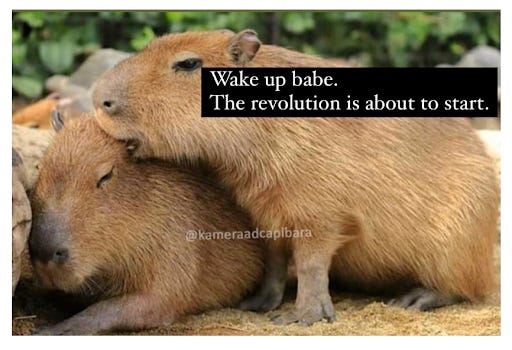Your memes could be artistic interventions
Researcher Chloë Arkenbout writes about how memes can be more than fun games – they can also be a valuable artistic or political expression
Dear friends,
When I tell people I research memes for a living they often laugh in my face. But you see, memes are not just funny images on the internet. If we look at the huge number of memes that circulate around the world every day, and how many people create and consume them, it makes sense to have a critical look at this phenomenon. We’re at a point where every historical event will be haunted with a memetic double. Memes, much like art, say a lot about our society's current state and have the potential to change it. And let’s be honest, our society could use some change.
Many see the meme as an online version of the editorial cartoon, and indeed, both use irony and cultural references to make a point. The meme, however, should be understood, as Anahita Neghabat points out, as a tool for rejecting the logic of exclusive, elitist, top-down knowledge production commonly performed by hegemonic, established media and political institutions. Because anyone with basic editing skills and internet access can make a meme. This gives them the political potential to change dominant norms. Geert Lovink and Marc Tuters have explained how memes can be seen as cultural negotiations that take place in the flow of everyday language, using Walter Benjamin’s metaphors on awakening and transformation. Or the ‘I never thought of it like that’ memes, as I like to call them.
And this political power of memes has moved beyond virtual images. Their effects are moving through digital infrastructures, policies, regulations, and bodies. If memes are used as a tool by the alt-right to mobilize people to storm the Capitol and play a substantial role in the Ukrainian war, they should also be used by the left to spark a revolution and create a world built on values such as justice, equality, solidarity, empathy, compassion, care, and love. Savriël Dillingh once explained how memes can mass produce hope, and give us the conceptual langue we are still missing to express the future we would like to see. Memes, much like speculative art and design, are tools for change. And I would rather be hopeful and see memes as a starting point to mobilize people to take action than to be nihilist and passive.

So if we look at memes like this, what are they really? Could they be a creative (research) practice tool or tactical artivistic intervention? Could they be a collective representation of a certain moment in time? Are they part of the cycle of life, death and creation? Could anything be a meme? I don’t know the answer to these questions yet, but I would love to invite you all to speculate about this with me. Or (allow me to shamelessly self-promote here) read about it in Critical Meme Reader III: Breaking the Meme, which Idil Galip and I are co-editing and will be published in 2024.
With love,
Chloë Arkenbout
Chloë Arkenbout works as a researcher at the Institute of Network Cultures in Amsterdam and is the co-editor of the three Critical Meme Readers; Global Mutations of the Viral Image (2021), Memetic Tacticality (2022) and Breaking the Meme (to be published in 2024). In addition, they work at the Communication & Multimedia Design program at the Amsterdam University of Applied Sciences where they mainly help students to critically reflect on their digital designs, in the context of the society they live in and the future they would like to see. She is also a member of the university’s research ethics committee where she works on subjects such as social safety.
This newsletter is part of the on- and offline program that follows the digitalisation issue. If you’d like to get access to the issue itself, you can get yourself a digital copy here.





